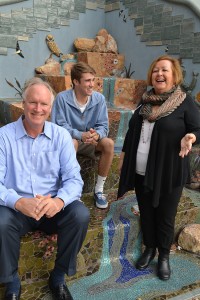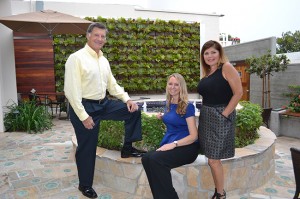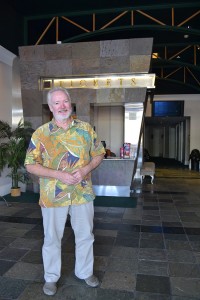As the end of another calendar year approaches, Coronado residents often look at end-of-year charitable giving opportunities. There is no shortage of needs among Coronado nonprofits. Here’s a look at the largest in three diverse areas — education, health care and the arts.
Coronado Schools Foundation
Heavy textbooks are gradually being replaced by curriculum written by teachers, which students access via their laptop computers and other devices.
As backpacks subsequently lighten up, it’s literally a big weight off students’ shoulders.
But now that weight has shifted onto those who raise the dollars to fund school programs, including technology and curriculum development.
Much of that responsibility falls to the Coronado Schools Foundation (CSF).
Beginning in 2005, CSF began paying not only for programs but also teacher salaries. “We began with a five-year commitment for a technology resource teacher so that there would be someone at each campus to teach the teachers on the use of instructional technologies as well as work with the students,” said Patty Cowan, the foundation’s CEO.
”We don’t write the district a blank check,” said Cowan, noting that CSF funds programs that aren’t state mandated. “We apportion it equitably across school sites. Each school’s leadership team determines their highest needs in accordance with the school’s strategic plan. Then it comes to our board for review.”
While much of the funding goes to technology, funding also covers the arts, such as a Shakespeare festival at the high school and a visual and performing arts teacher at Silver Strand Elementary.
In 2013, when the California legislature redrafted its funding guidelines, Coronado Unified School District came out at the bottom of the financial pyramid. It is now funded in the lowest 10 percent of districts statewide, due to its demographics, including a low percentage of English-language learners and students from lower socio-economic backgrounds. Today, San Diego schools receive $1,500 more per child per year from the state. “So, if you multiply our 3,200 kids by $1,500, that’s $4.8 million less that our district receives than if those students were part of San Diego Unified,” Cowan said.
Not surprisingly, it’s parents who contribute the bulk of funds to the foundation each year, said Jim Grady, CSF’s vice chairman. “Parents love their kids and want the best for their future generations.”
But Coronado’s parents also include grandparents,” Cowan said. “I have grandparents from Texas who call me every year during the telethon.”
The spring telethon — organized and run by the district’s students at all grade levels — is one of two CSF annual fundraisers; the second is the fall auction.
Grady said that many businesses in town also support CSF through events and its Partners in Education program. “Everyone wants to live in an excellent community, and a great school district really keeps our property values up. It’s one of the first thing prospective homebuyers look at.”
With test scores that have traditionally been among the highest in San Diego County, Coronado schools offer programs found in both top-rated public and private schools. The cost of a private school education in San Diego, Grady noted, can be as high as $20,000 to $30,000 a year — per child.
The foundation also maintains an endowment fund of $6 million. Established in 1996, the endowment got a major boost from a $3.8 million gift from the Fran Harpst estate in 2010. And $500,000 in private scholarships to graduating high school seniors is endowed in perpetuity and managed by the foundation.
Cowan noted that $7.9 million has been raised by CSF to date “and 70 percent of that was in the last 11 years,” she said. “We’ve ‘professionalized’ our board and staff.” She notes that in 2004, CSF had 2.5 full-time employees and returned $163,000 to the schools; today it has four full-time employees and returns over $800,000 a year.
The lack of bureaucracy and being able to see the impact of funding on education has led Cowan to remain in her position for 12 years. She also points to the dedication of CUSD teachers, many of whom donate to the foundation in monthly allotments.
Coronado Hospital Foundation
The power of asking — extending an invitation — plays a powerful role in fundraising, said Nora Boswell, chief development officer at the Coronado Hospital Foundation (CHF).
“Sometimes, it’s as simple as inviting a person to share a cup of coffee to get better acquainted,” said Boswell, who has been with the foundation for four years. “My primary role is major gifts fundraising, as well as planned giving. I try to connect people with the things that are important to them and that will make the most impact on the hospital. And so I’m really focused on our capital campaigns and strategic plans.”
Sandy Gross, senior development officer at the foundation, heads up CHF’s annual gala, now in its 29th year, and golf tournament, which just concluded its fifth year.
Boswell said that many donors are grateful patients and community members who value having a hospital on the island. One such donor was the late Willene Coyle. “She had some great experiences with hospital staff, including the emergency department,” Boswell said. “And in her estate gift, she identified that she would like to fund our emergency department services.”
“She made an impact by donating generously to our galas each year,” Gross said. “And she left us so much in her will … a portion of her home, jewelry, artwork, furs, furniture.”
Coyle was the next-door neighbor to Darlene Shirey, who invited her to attend a hospital gala.
“The gala,” Boswell said, “is often an individual’s first introduction to the hospital. Subsequently, we’ll often invite gala attendees to meet one-on-one to learn more about the hospital.”
Former Coronado Mayor Tom Smisek now chairs the foundation board. His involvement also began because someone asked.
“Peggy Golden invited me to join right after I left office,” Smisek said. Smisek explained the city’s unique funding support for the hospital. “Not so many years ago, the hospital was running in the red. The deficit got up to $13 million. So former CEO Marcia Hall, a couple of her foundation presidents and former city council representative Frank Tierney approached the city for help. We devised a matching campaign, using Community Development Agency funds, to support capital projects at the hospital. The two-for-one matching grant finishes in 2017.”
Meanwhile, Smisek explained, things have turned around, and the hospital is now $20 million to the plus side. Over the past decade, Coronado Hospital Foundation has raised more than $25 million, in support of capital projects. The impact of these funds has upgraded much of the hospital facilities, including the ER, ICU, first floor corridors, medical surgical unit lobbies, cafeteria and introduced the “Sewall Healthy Living Center” for exercise and physical therapy in a spalike setting. The final project that will qualify for city matching funds is the Payne Family Outpatient Pavilion. This year’s golf tournament kicked off the year strong with the hospital medical staff’s contribution.
Gross said, “The staff jumped in on our golf tournament and gave us $50,000 this year. They really want to support the new Outpatient Pavilion!” Boswell added, “We hope the community will embrace the project during the upcoming season of giving!”
Lamb’s Players Theatre
Twenty-two years ago, Lamb’s Players Theatre opened its doors in the Spreckels Building, marking the birth of a new day for what was then a tired and half-deserted main street area.
“We’ve seen 28 restaurants open within walking distance of the theater since we opened,” said Robert Smyth, Lamb’s producing artistic director.
Smyth points to three reasons people donate to the performing arts — and to Lamb’s Player Theatre in particular.
“They understand what a professional theater company can do for a community from a business standpoint. We have 300 people a night coming to the Village, and they often go out to eat and shop.
“Second, they value the culture that a vibrant arts organization brings to a community and the health that connection brings to kids. We have a summer youth camp program and tour to schools. We aren’t just entertainment — we’re also about education and cultural conversation. People support us because we are the voice of hope at the larger cultural table.
“And finally, there are people who support us because they love us,” Smyth said, a smile spreading across his face. “They recognize the commitment we bring to our work. They have a relationship with us.”
Relationships are important to Lamb’s. “We spend a lot of time thanking people,” Smyth said. “The reason this place is here is because our donors make it possible.”
Smyth noted that the cost for producing nonprofit live theater is dependent on fundraising. “If you look at ticket prices for commercial theater in New York and touring Broadway shows, you realize you’ll need to pay twice to five times as much as we charge. Our donor teams allow us to offer half-price tickets to students. We want them to come in and get comfortable — and dare I say addicted — to live theater.”
Lamb’s Players, which hires more local actors than any theater in San Diego County, earns more than 80 percent of its annual budget. “The average is 56 percent,” Smyth said. “We do that by punching way above our weight class. We do work that would normally be produced by a much larger company.”
Lamb’s fundraisers place an emphasis on fun, such as the 100 hours of round-the-clock performances that broke a Guinness World Record and raised $200,000. “A lot of people contributed,” Smyth said. “It was complicated; Guinness was very exacting. We had to have Guinness judges and videotape everything. We couldn’t have more than two-minute breaks and at least 20 people in the audience at all times.”
Lamb’s was founded 45 years ago, operating in National City, closing that stage shortly after its move to Coronado. Lamb’s has mounted performances over the past five years at the Gaslamp’s Horton Grand Theatre, and this year will showcase An American Christmas at the U.S. Grant Hotel, which was built by Ulysses S. Grant, Jr. in 1910.
But Coronado remains at the heart of Lamb’s Players Theatre. Smyth said that the patronage of the Coronado community has been rewarding: while the national average is two percent, in Coronado, 10 percent of the community regularly attends Lamb’s performances.
Smyth is glad he and his wife, Deborah, chose to make Coronado their home.
“The remarkable gifts we have here — in health care, the arts, education, service clubs, sports teams — are all the reasons this place is truly a paradise,” he said.




